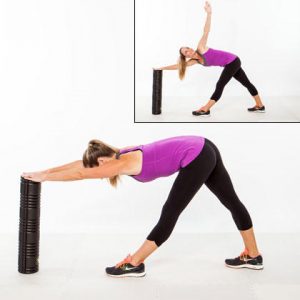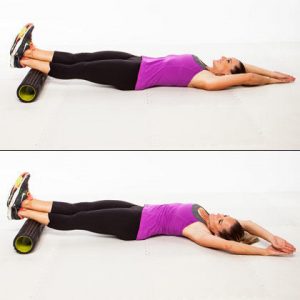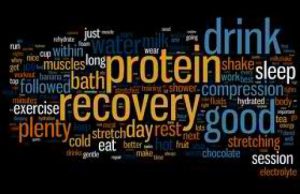
Recovery is super important. I’ve been working out for a long time but until recently my recovery was not optimal. It was OK but it wasn’t as good as it could be.
(By the way, I’m not a doctor and none of this is medical advice. Don’t do anything that your doctor doesn’t give you clearance for.)
What Happens if You Don’t Recover Optimally
Any type of workout creates a stress. That stress has to be recovered from before you see an increase in performance.
If you never give yourself a chance to fully recover between workouts you will find your performance quality decreasing.
Some people call that “over training”. The ideal combination is: workout causes stress – you recover from stress and get stronger – your performance improves.
What is Optimal Recovery?
I give credit to Mark Rippetoe and his team for doing the studies necessary to find the absolute best way to recover from hard workouts or sports practice.
You can find this info in their book: Practical Programming For Strength Training. I downloaded the kindle version (because it’s way cheaper) and just read it on my phone. I found out about this book from Starting Strength
1. Sleep
We all know that lack of sleep sucks. It leads to decreased motivation and performance by the athlete.
Sleep is when we secrete testosterone and growth hormone. If you lack sleep you will have less testosterone. 100% scientific fact. We need those hormones for recovery.
So how many hours do we need?
Mom was right, for athletes who are training hard we need 8 hours of sleep. You have to take into account that it takes 30 mins or so to fall asleep. That means you should add that time to the 8 hours.
If I can’t get 8 hours then I’ll try to sneak a nap in the middle of the day.
2. Water/Hydration
I work as a personal trainer and I have to stress to all of my clients: drink water! Especially if you are: large, an athlete, and move around a lot.
The amount of fluids you need to drink will not happen by accident. You need to drink at least 5 Liters if you are a serious athlete.
That’s what I shoot for. Like 5L for myself a 200lb athlete. This isn’t medical advice and you have to figure it out for yourself with experimentation.
3. Protein
Protein synthesis is how new muscle is built. We need protein for that. If you are working out a lot you are turning over a lot of protein.
A good rule of thumb I use is 1 gram of protein per pound of body weight. This is for men. Women may require less protein. My girlfriend weighs 145lbs and works out 4x per week. She gets about 100g of protein per day.
You can google what you eat in a daily basis and find out how much protein you are getting. If you aren’t getting enough you can drink protein shakes .
5. Vitamins and Minerals
If you have the money just take a few vitamins and minerals. A special note here is that: most women in North America are deficient in calcium and iron.
You need optimal levels of calcium and iron for good sports performance. Even a mild iron deficiency can have a big negative impact on your ability to recover.
You can ask your doctor to check these when you get your Blood Tests Done .
6. Omega 3
Omega 3 and 6 are not made by your body and they are critical to recovery and immune function. Omega 6 we got a lot of it in our diets.
The main one is Omega 3, that’s what we want to supplement with. It has really helped raise my HDL cholesterol levels. I take large amounts of omega 3 every day.
And there some exercises and stretching movements that can help you , recover faster you can see in the below articles .
When it comes to maximizing your results, proper rest and recovery techniques are just as important as what you’re doing in the gym. But sometimes, like when you’re pumped about getting in shape (New Year’s resolution, anyone?), you don’t want to just sit and do nothing. And you shouldn’t. An “off day” doesn’t mean you can’t keep moving, even if you’re still feeling the burn from your last weight-lifting sesh. Do 1 to 3 sets of this gentle yet active circuit to help your muscles recover and to prepare your body to accomplish even more at your next workout.
You’ll need: A foam roller, mat or towel (optional).
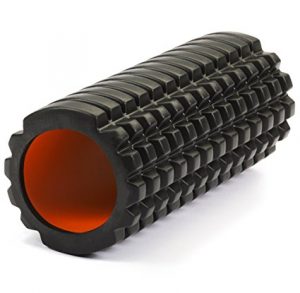
Slow Cyclone
This circular movement stretches the muscles in your abs, chest, and back while engaging your core muscles at the same time.
How to do it: Stand with feet wider than hip width, knees slightly bent, arms extended overhead, palms facing in. Keeping your pelvis still, slowly start to reach your upper body and arms to the left, then overhead (extending your spine and looking up), and then to the right, tracing a full circle. Repeat 5 times to the left, then 5 times to the right.
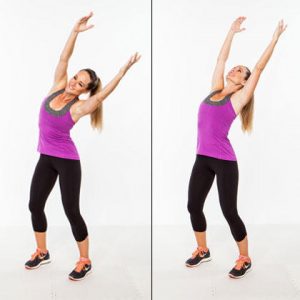
Back Extension Chest Opener
Stretch the front of your body and extend your spine to help your back stay healthy and aligned.
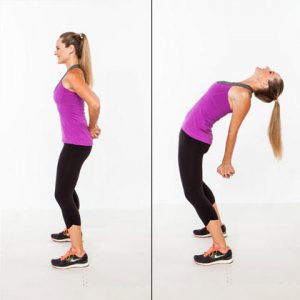
How to do it: Stand with feet wider than hip width, knees slightly bent, hands clasped behind your lower back. Extend spine and arms back, bending backwards as far as you feel comfortable going, pressing your pelvis forward. Slowly return to start. Repeat up to 5 times in a row.
Extended Triangle Twist
This yoga-inspired static pose uses the foam roller (and your core muscles) to help with balance as you stretch the muscles in your lower and upper body.
How to do it: Take a wide step forward with your left foot, keeping both feet flat on the floor. Hinge forward from your hips, and bring your chest parallel to the floor (soften your knees if needed), extending arms out overhead, palms pressed on top of the upright roller. Slowly rotate your torso to the left, reaching left arm overhead to the ceiling. Try to look up at your hand (if that strains your neck look straight ahead or down to the floor). Hold for 5 deep breaths and then reverse, repeating up to 3 times total on both sides.
Foam Roller Marches
You’ll release the muscles in your back, chest, and shoulders by lying on top of the roller while keeping your core and legs engaged during this balancing march.
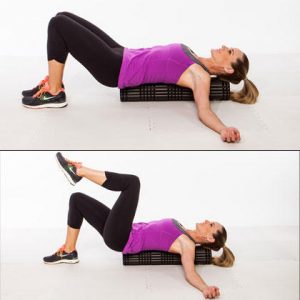
How to do it: Lie faceup on the roller (it should line up with your spine) with knees bent, feet hip-width apart and flat on the ground. Extend arms out to the sides, elbows bent and resting on the floor, palms facing up. Brace your abs in tight and slowly begin to march your legs one at a time off the floor. Your knee stays bent at 90 degrees while you raise it above your hip, keeping your body as still as possible. March, alternating legs, 20 times total.
Bridge and Release
Activate and then gently apply pressure to the muscles in your lower back with this contract-release combo move.
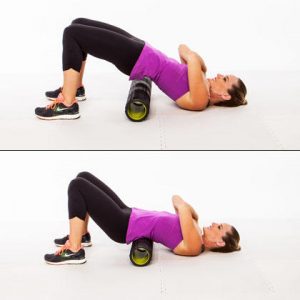
How to do it: Turn the roller so that it is perpendicular to your spine, and place it under your lower back (your upper body should be resting on the floor, knees bent, feet hip width and flat on the ground). Cross your arms over your chest and lift your hips into bridge pose, squeezing your glutes and lifting your hips with your lower back, for 5 counts. Slowly lower your hips and press your lower back into the roller, relaxing your glutes and legs and allowing your back to sink into the roller. Hold for 5 deep breaths. Repeat up to 3 more times.
Kneeling Hip and Quad Stretch
This pose is harder than it looks, but it offers a nice deep stretch for the hip flexors, quads, and even the chest.
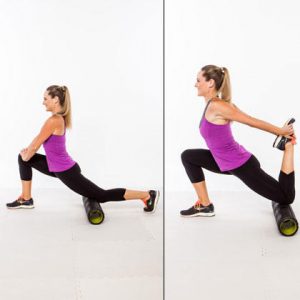
kneeling hip flexor quad stretch
How to do it: Begin kneeling, with the roller perpendicular to you on the floor. Step your right foot forward and over the roller, lunging into your leg, shifting your weight off of your back knee. Position the roller under your left thigh in front of your knee, tucking your toes under to lift up into a low lunge (just be sure to avoid putting pressure on top of your kneecap by positioning the roller in front of your knee at all times). If this is a deep stretch for you already, simply stay here and hold this position.
Rolling Cobra Contraction
This dynamic move combines the cobra with an abdominal knee tuck to help strengthen and stretch your abs and back.
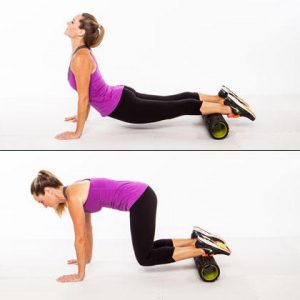
How to do it: Lie facedown with your shins resting on top of the roller, hip-width apart. Bend your arms and place your hands on the floor under your shoulders. Extend your spine and press down with your arms, lifting your hips off the floor as you extend back. Take a deep breath in, open your chest, press your shoulders down, and look up.
As you exhale, brace your abs in tight, lift your hips up in line with your shoulders, and bend your knees in under your hips (in a sort of elevated all-fours position with back naturally straight). Allow your legs to slide along the roller from your shins to the tops of your feet. Hold for 1 count, and then slowly roll legs back out and return to extended position. That’s one rep. Repeat 5 times in a row, slowly and with control.
Supine Stretch And Crunch
Chisel your abs and stretch your sides with this combo move.
How to do it: Lie face up with legs extended out straight, the roller placed under your calves. Cross your right leg on top of your left, feet flexed. Reach your arms overhead until they touch the floor, right hand stacked on top of your left palm. Brace your abs in tight, and slowly lean to the left, pressing your right hip to the side as you pull your left shoulder towards your left hip. Hold for 1 count and then slowly return to start. Repeat 5 times to the left, and then switch to the other side.
The above exercises are used to reduce the tenderness due to the damage occurred in the muscle tissue during the workout and to recover the body as well as its used as a release from stress , and a long with that rest and proper nutrition is mandatory after every workout , as post to the exercises the body requires a lot of minerals and protein to replace all the energy used during the workout especially for man’s and more hydration and vitamins are required for ladies post to the exercises .
Mostly fruits and a protein shake is recommended after exercises .

 musclesroom musclesroom is a designed website persons interested in fitness and supplements
musclesroom musclesroom is a designed website persons interested in fitness and supplements





